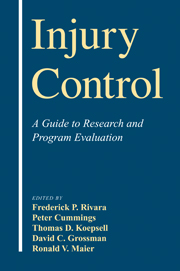Book contents
- Frontmatter
- Contents
- List of Contributors
- 1 An Overview of Injury Research
- 2 Classifying and Counting Injury
- 3 Measurement of Injury Severity and Co-morbidity
- 4 Data Linkages and Using Administrative and Secondary Databases
- 5 Rates, Rate Denominators, and Rate Comparisons
- 6 Data Collection Methods
- 7 Selecting a Study Design for Injury Research
- 8 Qualitative Methods in Injury Research
- 9 Randomized Trials
- 10 Cohort Studies in Injury Research
- 11 Case–Control Studies in Injury Research
- 12 Ecologic Studies
- 13 Case Series and Trauma Registries
- 14 Systematic Reviews of Injury Studies
- 15 Evaluating an Injury Intervention or Program
- 16 The Development of Clinical Decision Rules for Injury Care
- 17 Trauma Performance Improvement
- 18 Measuring Disability and Quality of Life Postinjury
- 19 Economic Evaluation of Injury Control
- 20 Ethical Issues
- Index
18 - Measuring Disability and Quality of Life Postinjury
Published online by Cambridge University Press: 16 October 2009
- Frontmatter
- Contents
- List of Contributors
- 1 An Overview of Injury Research
- 2 Classifying and Counting Injury
- 3 Measurement of Injury Severity and Co-morbidity
- 4 Data Linkages and Using Administrative and Secondary Databases
- 5 Rates, Rate Denominators, and Rate Comparisons
- 6 Data Collection Methods
- 7 Selecting a Study Design for Injury Research
- 8 Qualitative Methods in Injury Research
- 9 Randomized Trials
- 10 Cohort Studies in Injury Research
- 11 Case–Control Studies in Injury Research
- 12 Ecologic Studies
- 13 Case Series and Trauma Registries
- 14 Systematic Reviews of Injury Studies
- 15 Evaluating an Injury Intervention or Program
- 16 The Development of Clinical Decision Rules for Injury Care
- 17 Trauma Performance Improvement
- 18 Measuring Disability and Quality of Life Postinjury
- 19 Economic Evaluation of Injury Control
- 20 Ethical Issues
- Index
Summary
For every injury death there are approximately 18 nonfatal injuries resulting in hospitalization and 250 that are treated and released from emergency departments (Fingerhut and Warner, 1997). Although many of these nonfatal injuries are minor in nature and only result in 1 or 2 days of restricted activity, many others have far reaching consequences and are often significant enough to limit employment and recreation for the 40–50 years of life remaining for the typical patient. Productivity losses associated with nonfatal injuries alone have been shown to account for 40% of the total lifetime costs of injury (Rice et al., 1989; Miller et al., 1995). These considerations have challenged the field to find better ways to measure and monitor the impact of injuries in terms other than just lives saved. Measures of functional outcome, disability, and health-related quality of life are becoming increasingly important parameters in the evaluation of treatment and prevention strategies for reducing the burden of injury. In this chapter we begin with some definitions and an overall framework in which to discuss the epidemiology of injury outcome, proceed to a review of the most widely used measures of disability and health-related quality of life, and conclude with a discussion of the challenges ahead as we more broadly apply these measures in injury research and evaluation.
Defining Disability and Quality of Life: A Framework
A useful framework for distinguishing among different types of injury outcomes was first described by Nagi (1976) and more recently elucidated in two Institute of Medicine Reports, Disability in America (IOM, 1991) and Enabling America (IOM, 1997) (Figure 18.1). Nagi defined four related concepts of pathology, impairment, functional limitation, and disability.
Keywords
- Type
- Chapter
- Information
- Injury ControlA Guide to Research and Program Evaluation, pp. 250 - 269Publisher: Cambridge University PressPrint publication year: 2000
- 4
- Cited by

